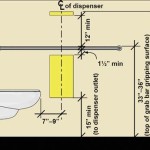How to Replace Bathroom Faucet Knobs
Bathroom faucet knobs can become worn, damaged, or simply outdated over time. Replacing them is a relatively straightforward DIY project that can significantly enhance the look and functionality of your bathroom sink. This guide will outline the necessary steps and tools for replacing bathroom faucet knobs, allowing you to tackle this task with confidence.
1. Gather Your Supplies and Tools
Before embarking on the replacement process, ensure you have the following supplies and tools readily available:
- New faucet knobs: Choose knobs that are compatible with your existing faucet. Measure the diameter of your old knobs to ensure a proper fit.
- Phillips screwdriver: Used to remove and install screws.
- Adjustable wrench: Used to loosen and tighten nuts.
- Channel-lock pliers: Used for gripping and turning stubborn components.
- Plumber's tape: Used to seal threads and prevent leaks.
- Rag or towel: Used to wipe away excess water and debris.
- Bucket: To catch any water that may leak out during the process.
- Optional: A small basin wrench for difficult-to-reach nuts.
2. Turn Off the Water Supply
The most crucial step is ensuring the water supply to your bathroom faucet is shut off before you begin. This will prevent any unexpected flooding during the replacement process. Locate the shut-off valve for your sink, usually found underneath the sink, and turn it fully counter-clockwise. To confirm the water supply is off, try turning on the faucet. No water should flow.
3. Remove the Old Faucet Knobs
With the water supply turned off, you can now proceed to remove the old faucet knobs. Depending on the type of faucet, the removal process may vary slightly:
- Screw-on knobs: Typically, these knobs have a small screw located on the top or side. Use a Phillips screwdriver to loosen and remove the screw. Once the screw is removed, the knob should easily pull off.
- Push-on knobs: These knobs usually have a small hole on the top or side. You can use a small tool, such as a screwdriver or a paperclip, to pry up the knob from the stem.
- Lever handles: Some faucets feature lever handles instead of knobs. These handles usually have a set screw located on the side. Use a screwdriver to loosen and remove the screw, and then the handle should easily detach.
4. Remove the Old Stems
Once the knobs are removed, you'll need to access the stems that connect the knobs to the faucet. This generally involves removing a decorative escutcheon plate that covers the stem.
- Escutcheon removal: Look for small screws that secure the escutcheon plate to the sink. Use a screwdriver to loosen and remove these screws. The escutcheon plate should then lift away, revealing the stems underneath.
- Stem removal: Each stem typically has a nut connecting it to the faucet body. Use an adjustable wrench to loosen and remove this nut. Once the nut is removed, the stem should pull out easily.
5. Install the New Stems
Now that you've removed the old stems, it's time to install the new ones. The new stems should come with new packing nuts. Before installing the new stems, it's crucial to apply plumber's tape to the threads of the new stems. Wrap the tape tightly around the threads, ensuring it covers the entire length. This will help to create a watertight seal when you tighten the nuts.
Next, thread the new stems into the faucet body, ensuring they are seated properly. Use the adjustable wrench to tighten the nuts connecting the stems to the faucet body. It's important to tighten the nuts securely without overtightening, as this can damage the faucet.
6. Install the New Faucet Knobs
With the new stems in place, you can now install the new faucet knobs. The installation process is the reverse of the removal process:
- Screw-on knobs: Align the knob with the stem and gently push it down. Once the knob is in place, screw the small screw back into the knob to secure it.
- Push-on knobs: Align the knob with the stem and gently push it down until it clicks into place.
- Lever handles: Align the lever handle with the stem and push it down. Once the handle is in place, secure it by tightening the set screw on the side.
7. Reinstall the Escutcheon Plate
If you removed an escutcheon plate, now is the time to reinstall it. Place the plate back over the stems and secure it to the sink using the small screws you removed earlier.
8. Turn On the Water Supply
After installing the new knobs, you can finally turn the water supply back on. Slowly open the shut-off valve, checking for any leaks. If you find any leaks, tighten the nuts connecting the stems to the faucet body, or reapply plumber's tape to the threads.
Replacing bathroom faucet knobs is a simple but effective way to enhance the aesthetics and functionality of your bathroom sink. By following these instructions and taking your time, you can confidently complete this project yourself, saving both time and money.

How Do I Replace Bathroom Sink Faucet Handles Cleaning More

How To Change The Handle Rotation On A Faucet

How To Replace Bathroom Sink Faucet Handles Ehow

How To Remove Moen Bathroom Faucet Handle In 2 Steps

How To Remove And Install A Bathroom Faucet

How To Tighten Faucet Handle Homeserve Usa

Tips Tricks Remove Delta 2 Handle 4 In Bathroom Sink Faucet With Bar 5 21 18

Replacing A Bathroom Faucet Fine Homebuilding

How To Fix A Stripped Faucet Handle In 10 Minutes Or Less

Help Removing Bathroom Faucet Handle Doityourself Com Community Forums
Related Posts







